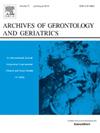硒蛋白P预测急性呼吸困难患者的死亡率。
IF 3.5
3区 医学
Q2 GERIATRICS & GERONTOLOGY
引用次数: 0
摘要
背景和目的:良好的硒(Se)状态预示着各种疾病的良好预后和总体死亡率的降低。该研究的主要目的是确定硒状态,即硒蛋白P (SeP)水平是否与急诊科(ED)急性呼吸困难老年患者90天死亡率风险相关。方法和结果:2013年至2018年期间,在Malmö大学医院急诊科招募了出现呼吸困难的患者。采用Cox回归分析评估90天死亡率的风险比(hr)。这个分析分两个步骤进行。模型A包括年龄和性别的调整,个体因素如SeP水平、医疗紧急分类和治疗系统-成人(METTS-A)、BMI水平、合并症和吸烟状况,95%置信区间(95% CI)。模型B是一个具有99%置信区间(99% CI)的多变量分析,纳入了年龄、性别和模型a中具有统计学意义的因素,包括SeP水平、BMI、心力衰竭、贫血和中风。较低的SeP浓度与90天内较高的死亡风险独立相关。在SeP连续模型中,HR为0.798 (99% CI 0.678 ~ 0.940)。当比较SeP的最低四分位数与最高四分位数时,HR为2.462 (99% CI 1.240-4.891)。结论:低SeP浓度可预测出现呼吸困难的ED患者90天死亡率。SeP水平的评估可作为对老年急诊科患者进行初步评估的一个有价值的工具。本文章由计算机程序翻译,如有差异,请以英文原文为准。
Selenoprotein P predicting mortallity in acute ill patients with dyspnea
Background and aims
Good Selenium (Se) status predicts favorable prognoses for various diseases and a reduced overall mortality.
The primary objective of the study was to determine whether Selenium status, i.e. Selenoprotein P (SeP) levels, is associated with risk of 90-day mortality in elderly patients with acute dyspnea at the Emergency Department (ED).
Methods and results
Patients presenting with dyspnea were enrolled from the ED at the University Hospital in Malmö between 2013 and 2018. Cox regression analyses were conducted to evaluate hazard ratios (HRs) for 90-day mortality. This analysis was performed in two steps. Model A included adjustments for age and sex with 95 % confidence intervals (95 % CI) for individual factors such as SeP levels, the Medical Emergency Triage and Treatment System – Adult (METTS-A), BMI levels, comorbidities, and smoking status. Model B was a multivariate analysis with 99 % confidence intervals (99 % CI), incorporating age, sex, and statistically significant factors from Model A, including SeP levels, BMI, heart failure, anemia, and stroke. A lower concentration of SeP was independently associated with a higher risk of death within 90 days. In the continuous model of SeP, the HR was 0.798 (99 % CI 0.678–0.940). When comparing the lowest quartile to the highest quartile of SeP, the HR was 2.462 (99 % CI 1.240–4.891).
Conclusion
Low SeP concentrations were found to predict 90-day mortality in ED patients presenting with dyspnea. The assessment of SeP levels could serve as a valuable tool in the initial evaluation of elderly patients in the ED.
求助全文
通过发布文献求助,成功后即可免费获取论文全文。
去求助
来源期刊
CiteScore
7.30
自引率
5.00%
发文量
198
审稿时长
16 days
期刊介绍:
Archives of Gerontology and Geriatrics provides a medium for the publication of papers from the fields of experimental gerontology and clinical and social geriatrics. The principal aim of the journal is to facilitate the exchange of information between specialists in these three fields of gerontological research. Experimental papers dealing with the basic mechanisms of aging at molecular, cellular, tissue or organ levels will be published.
Clinical papers will be accepted if they provide sufficiently new information or are of fundamental importance for the knowledge of human aging. Purely descriptive clinical papers will be accepted only if the results permit further interpretation. Papers dealing with anti-aging pharmacological preparations in humans are welcome. Papers on the social aspects of geriatrics will be accepted if they are of general interest regarding the epidemiology of aging and the efficiency and working methods of the social organizations for the health care of the elderly.

 求助内容:
求助内容: 应助结果提醒方式:
应助结果提醒方式:


